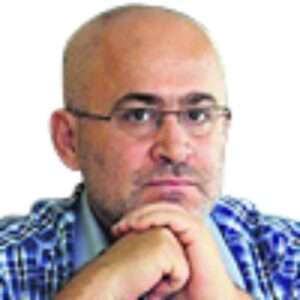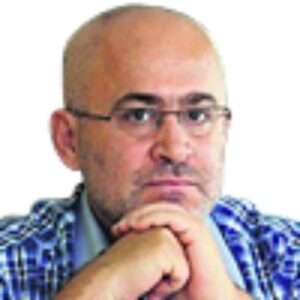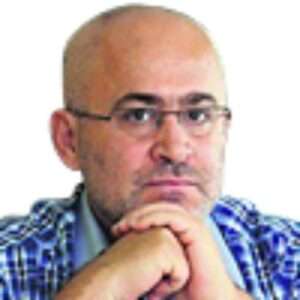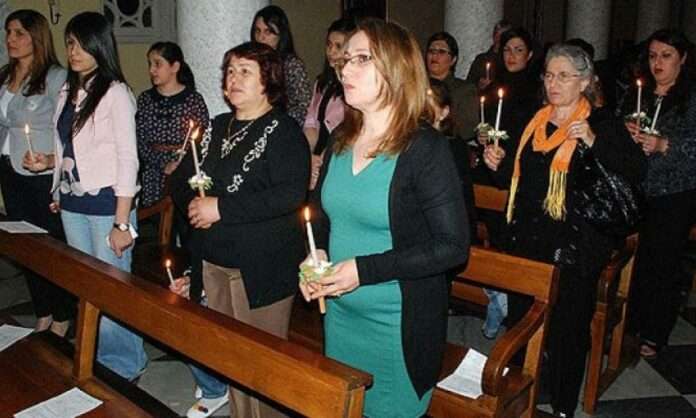 Orhan Kemal Cengiz
Orhan Kemal Cengiz
ΟΟρχάν Κεμάλ Τζενγκίζ είναι Τούρκος δικηγόρος, δημοσιογράφος και ακτιβιστής για τα ανθρώπινα δικαιώματα. Αποφοίτησε από τη Νομική από το Πανεπιστήμιο της Άγκυρας το 1993. Από το 1997 έως το 1998 εργάστηκε στο Λονδίνο. Είναι πρόεδρος και ιδρυτικό μέλος του Human Rights Agenda Association.
Ο ίδιος αναφέρει σε βαρυσήμαντο άρθρο του ότι “υπάρχουν πολλά περιστατικά, που μας αποκάλυψαν την παρουσία Κρυπτοχριστιανών, οι οποίοι βγαίνουν ανοιχτά πλέον στην Τουρκία, και διεκδικούν την ταυτότητά τους, υπολογίζοντας την πραγματικότητά, και αυτό φαίνεται ότι λειτουργεί ως καταλύτης για να κάνουν και άλλοι το ίδιο.
Όπως επισημαίνει η συγγραφέας Vercihan Ziflioglu στο βιβλίο της, «The Story of the Armenians in Purgatory», η δολοφονία του Hrant Dink στις 19 Ιανουαρίου 2007 ήταν ένα από τα πιο σημαντικά σημεία καμπής στη χριστιανική αυτοδιάθση στην Τουρκία.
«Ο θάνατος του Dink έσπασε έναν αιώνα σιωπής και σιγά σιγά άρχισαν να αναδύονται οι Κρυπτοχριστιανοί Αρμένιοι».
Αν και η δολοφονία του Hrant Dink θεωρήθηκε ότι ήταν η δολοφονία ενός Αρμένιου που ήταν πολύ ειλικρινής και πολύ τολμηρός στη διεκδίκηση της ταυτότητάς του, η τεράστια δημόσια κατακραυγή κατά της δολοφονίας του, προκάλεσε μια ισχυρή έκφραση της αρμενικής ταυτότητας και της αλληλεγγύης χιλιάδων Αρμενίων στην Τουρκία.
Οι δεκάδες χιλιάδες άνθρωποι που παρευρέθηκαν στην κηδεία του Χραντ Ντινκ φώναξαν «Είμαστε όλοι Αρμένιοι» και έφεραν πανό και πλακάτ που έφεραν αυτή τη διακήρυξη στα Αρμενικά, Τουρκικά, Αγγλικά, Κουρδικά και άλλες γλώσσες.
Μια τέτοια κοινωνική αντίδραση δεν είχε προηγούμενο στην Τουρκία.
Αυτή η μνημειώδης δημόσια αντίδραση στη δολοφονία του Ντινκ μετέτρεψε την αυτοδιάθεση των Αρμενίων, από κάτι για το οποίο πρέπει να ντρεπόμαστε, σε κάτι που πρέπει να διεκδικήσουμε, ενθαρρύνοντας τους εξισλαμισμένους Αρμένιους να βγουν να το πουν ανοιχτά.
Σύμφωνα με τον Ziflioglu, ένας άλλος παράγοντας που επιτάχυνε την αποκατάσταση της αρμενικής ταυτότητας ήταν η αποκατάσταση και η επαναλειτουργία των ιστορικών αρμενικών εκκλησιών στο Ντιγιαρμπακίρ, το Βαν και στην Καισάρεια.
Για παράδειγμα, η αποκατάσταση της αρμενικής εκκλησίας στο Ντιγιάρμπακιρ προκάλεσε μεγάλο ενθουσιασμό στους Κρυπτοχριστιανούς Αρμένιους.
Αυτοί, άρχισαν να «συμμετέχουν στη διαδικασία αποκατάστασης, ακόμη και να αναλαμβάνουν καθήκοντα, να προστατεύουν και να παρακολουθούν την εκκλησία τους».
Ομοίως, το ότι το τουρκικό Υπουργείο Πολιτισμού ανέλαβε τις επισκευές του Καθεδρικού Ναού του Τιμίου Σταυρού το 2000, δημιούργησε την αντίληψη ότι το τουρκικό κράτος είχε κάνει ένα νέο άνοιγμα στις μειονότητες.
Η ροή Αρμένιων τουριστών και πιστών από άλλα μέρη της Τουρκίας και από το εξωτερικό στις εκκλησίες στο Βαν και στο Ντιγιάρμπακιρ, και οι επαφές που έγιναν μεταξύ Κρυπτοχριστιανών Αρμενίων και αυτών των επισκεπτών, επέσπευσαν την αποκατάσταση της χριστιανικής τους ταυτότητας.
Χιλιάδες Κρυπτοχριστιανοί γυρνούν στην πατρογονική θρησκεία τους
Ωστόσο, οι Κρυπτοχριστιανοί, Έλληνες και Αρμένιοι που έχουν κάνει το έργο της δημόσιας ανάκτησης της ιστορικής τους ταυτότητας δεν έχουν αγκαλιαστεί θερμά από την Ελληνική και την Αρμενική Εκκλησία.
Αντίθετα, οι Αρμένιοι της Κωνσταντινούπολης και οι Αρμένιοι της διασποράς έχουν αποκλείσει τους Κρυπτοχριστιανούς Αρμένιους από την Αρμενική Αποστολική Εκκλησία, ενώ το Οικουμενικό Πατριαρχείο έχει εκφράσει μόνο ένα «επιφυλακτικό καλωσόρισμα» στους Κρυπτοχριστιανούς Έλληνες.
Σε αυτό το πλαίσιο, είναι σημαντικό να θυμηθούμε ότι το ενδιαφέρον του Οικουμενικού Πατριαρχείου για τους εξισλαμισμένους χριστιανούς θα μπορούσε να θεωρηθεί αρνητική ενέργεια στην Τουρκία, και ως μια μορφή ιεραποστολικής δραστηριότητας.
Η επαφή με τους Έλληνες που έχουν ανακτήσει την ταυτότητά τους στην Τουρκία, μπορεί επίσης να θεωρηθεί ως ζήτημα ασφάλειας για το Οικουμενικό Πατριαρχείο.
Ενώ για τους Έλληνες η διαδικασία της αποδοχής και της αποκατάστασης λαμβάνει χώρα κυρίως σε ατομική βάση, για τους Αρμένιους αυτή η διαδικασία έχει συλλογική μορφή.
Παλαιότερα οι Κρυπτοχριστιανοί Αρμένιοι είχαν ιδρύσει οργανώσεις όπως η Ένωση Αρμενίων του Δερσίμ, η Ένωση Αρμενίων Μπιτλίς και η Ένωση Αρμενίων της Σίβας.
Πιο πρόσφατα, τον Νοέμβριο του 2022, οι Αρμένιοι στο Adiyaman σχημάτισαν μια ένωση που ονομάζεται HAYDER.
Η ίδρυση αυτών των ενώσεων φαίνεται ότι διευκόλυνε και επιτάχυνε την μεταβολή και την αποκατάσταση της ταυτότητας των Αρμενίων που ζουν στην Τουρκία.
Για παράδειγμα, αυτές οι ενώσεις διευκολύνουν την απόδειξη της αρμενικής ταυτότητας που απαιτείται από το Αρμενικό Πατριαρχείο πριν από το βάπτισμα.
Οι Αρμένιοι που αποδεικνύουν τις ρίζες τους μέσω αυτών των ενώσεων γίνονται δεκτοί στην Αρμενική Αποστολική Εκκλησία αφού ενημερώσουν την καταχώριση θρησκείας, στα κρατικά δελτία ταυτότητάς τους και ολοκληρώσουν έξι μήνες εκπαίδευσης.
Η Ελληνική Ορθόδοξη Εκκλησία έχει θέσει επίσης όρους για τους Έλληνες της Τουρκίας, οι οποίοι επιθυμούν να ανήκουν στην προγονική τους εκκλησία, συμπεριλαμβανομένης της θρησκευτικής εκπαίδευσης. Ορισμένοι υποψήφιοι καλούνται επίσης να μάθουν ελληνικά.
Τα βήματα που έγιναν από τους Αρμένιους και τους Έλληνες της Τουρκίας για να αναγνωρίσουν την κληρονομιά τους και να επανακτήσουν την ταυτότητά τους αντιπροσωπεύουν αναμφίβολα μια πρόοδο στα ανθρώπινα δικαιώματα.
Μετά από έναν αιώνα μυστικότητας, αυτή η αναγνώριση και η ανάκτηση είναι ένα τεράστιο επίτευγμα.
Ωστόσο, δεν μπορούμε να πούμε ότι αυτοί οι πολίτες της Τουρκίας είναι σε θέση να ασκήσουν πλήρως το δικαίωμά τους στην θρησκεία τους, έως ότου η Τουρκία αντιμετωπίσει την ιστορία και τις συνθήκες που έκαναν αυτή την ταυτότητα να είναι θαμμένη και απρόσιτη για τόσο μεγάλο χρονικό διάστημα.
Στα πρόσφατα άρθρα μου, έχω τονίσει σταθερά τη σημασία της συμφιλίωσης με το παρελθόν για την Τουρκία.
Προφανώς, η αντιμετώπιση των πληγών του παρελθόντος είναι μια πολυδιάστατη διαδικασία.
Είναι σαφές, ωστόσο, ότι η Τουρκία δεν έχει σημειώσει σημαντική πρόοδο σε αυτό το θέμα”, καταλήγει ο ίδιος, δημοσιοποιώντας ένα τεράστιο ζήτημα που αφορά την Ελλάδα και τους Έλληνες για τους συμπατριώτες τους που ζουν ακόμη μετά το0 1922, στα ιερά χώματα της Μικράς Ασίας.
ΤΑ ΑΡΘΡΑ ΣΤ ΑΓΓΛΙΚΑ
Islamized Christians of Turkey (1)
 Orhan Kemal Cengiz
Orhan Kemal Cengiz
In Turkey, the survivors of the 1915 Armenian Genocide and their descendants are sometimes called “remnants of the sword.” The use of this phrase admits that a mass killing has occurred with some survivors having escaped the genocide. Besides this phrase, which has been used for many years, other phrases describing descendants of Armenian Genocide survivors have proliferated in the last two decades.
In her book “The Story of the Armenians in Purgatory,” Vercihan Ziflioglu notes that phrases such as “Crypto-Armenians,” “Muslim Armenians,” and “Islamized Armenians” are also in use. These terms all refer to the same social phenomenon: The genocide caused some Christian Armenian citizens of Turkey to hide their religious identity, with the result being that their descendants have continued to conceal this identity, may know very little about it, or may even have become unaware of their religious and ethnic heritage.
A similar phenomenon, though not as well known, has occurred among the survivors of the 1914—1923 massacres targeting the Greek community, and among those Greeks who remained in Anatolia after the 1923 Turkish-Greek population exchange. Gercek News recently published a piece about a parallel of this phenomenon experienced by Alevized Armenians in the Dersim region. The Gercek News article shows that the Armenians living in Dersim and the ones who escaped the genocide and took refuge in this region became Alevis to protect their lives and their integrity.
In order to remain whole, to survive, or even to simply exist in Turkey, these minority members had to assume another identity. Some adopted their new Muslim identity with sincere belief, becoming Muslims even to themselves. Others saw their former identity as the true one and never abandoned it, but hid it carefully. Some who secretly remained Christian passed on this “inner knowledge” to the next generations, while others avoided telling their children about their family origins to protect them.
In the Turkish nationalist narrative, the prefix “crypto,” attached to a religious identity, is used as a pejorative. It insults the holder of the identity, implying that he or she is unreliable. This use of “crypto” implies that though the identity holder had the choice to live openly and honestly as a member of a particular religion, he or she deliberately chose to deceive others instead.
On the one hand, the concept of “secret Christians” can be viewed as a component or a subtopic of Turkey’s failure to face its past. The burden of horrific events in Turkish history is displaced from the perpetrators and their heirs to the victims and their descendants. Instead of confronting the sins of our grandfathers and grandmothers, we point the finger at the victims of those sins and accuse them of freely choosing secrecy and deception.
On the other hand, this great tragedy of forced hidden religious identity merits an analysis of its own as a unique problem that cannot be fully addressed under another topic. This problem is the denial of a right to identity. I frame the concept in this way because when these hidden Christians became known, neither the wider Muslim community nor the representatives of Turkey’s minorities accepted them.
These individuals’ right to identity and Turkey’s need to confront its past intersect and overlap. If Turkey had confronted its past, its relationship with all its minorities would have undergone a profound change. If we imagine an atmosphere in which the Armenian Genocide has been fully confronted, we see that Armenians in Istanbul would be regarded as the grandchildren of genocide victims. However, the identity of “hidden Armenians” is more nuanced and complex than simply being the grandchildren of genocide victims. “Hidden Armenians” are victims not only of the genocide but also of another grave violation of rights that is not included in the acknowledgement of 1915. Their identities—whether destroyed or merely hidden—have been denied them. They lost family members to the genocide and somehow survived themselves, but this survival came at the cost of all ties to their ancient culture and identity.
The right to identity is recognized under international human rights law as an autonomous, independent right that includes the right to one’s name, family, and culture. From this perspective, it is evident that the right of Islamized (or Alevized) Armenians and Greeks to their own names, families, and cultural identities is subject to severe, ongoing violation. For had these Islamized minorities not found themselves forced to convert, had they had an uninterrupted connection with their ancestry and heritage, they would have had different names and different family histories, and would have inherited a different culture. Although it can be said that such losses occur during any assimilation, the word “assimilation” is inadequate to describe the intensity and destruction of the loss at play in Turkey where there has been a complete erasure of identity.
We do not know exactly how many Armenians remained in Anatolia after the Armenian Genocide or how many Greeks remained in Turkey after the population exchange. However, some estimates have been made using existing data. According to estimates by the Armenian Patriarchate, an estimated 100,000 Armenian women and children remained in Anatolia following the genocide. No such comparable data exists regarding the Greek minority.
The Greeks and Armenians who remained in Anatolia after the massacres, population exchanges, and genocide experienced further social fracturing. Taking Armenian families as an example, we see that some remained Christian, some truly became Muslim, and some split, with part of the family maintaining a Christian identity and the other part becoming devout Muslims. It is also known that some Armenian families adopted a Kurdish-Alawite identity, especially in the Dersim region. Still others, though they converted to Islam, intermarried only with other Islamized Armenian families, and saw themselves as Muslims of Armenian ethnicity.
These Anatolian Christians were, in a way, absorbed by the social structures surrounding them. On the one hand, they produced new forms of existence within the wider Muslim community, while on the other hand, they kept alive the beliefs and cultures they carried from the past in various forms. For example, as researcher Mert Kaya points out in “The Islamization of Anatolian Greeks between the years 1919-1925: A study of memory,” the Christian tradition of egg painting continued until recently in these Islamized families. And although Islam generally forbids the consumption of alcohol, among these families were liquor and wine producers. Likewise, many traditions unrelated to Islam, mostly in accordance with the Christian faith, continue to live on in Turkey’s Black Sea region. These include customs such as using coffins to bury the dead and participating in activities that reflect the church calendar.
The stories of Islamized Greeks and Armenians learning their true identities differ greatly. For some, this identity is something they had always intuited from clues in their environment. For example, some secret Armenians living in southeastern Turkey say they were referred to by their neighbors as “Mıslimeni.” This Kurdish word literally means “Muslim,” but according to Ziflioglu, was used to denote converts to Islam. In other cases, older family members were aware of their past and origins, but kept this knowledge from other individuals within the family.
When it comes to this knowledge of identity, the state is undoubtedly in the greatest position to recognize Islamized Christians who are unaware of their own background. Turkey has kept detailed demographic statistics of the family histories of its citizens and thus has access to everyone’s genealogy, including those of so-called “secret” Greeks and Armenians.
In the upcoming part, we will discuss the developments that helped these “Islamized Christians” reclaim their identities.
Islamized Christians of Turkey (2)
 Orhan Kemal Cengiz
Orhan Kemal Cengiz
A few incidents, especially those involving hidden Christians coming out into the open, claiming their identities, and reckoning with their reality, seem to have served as a catalyst for others to do the same. As writer Vercihan Ziflioglu points out in her book, “The Story of the Armenians in Purgatory,” the January 19, 2007 murder of Hrant Dink was one of the most important turning points in Christian self-recognition: “Dink’s death broke a century of silence, and bit by bit the Crypto-Armenians began to emerge.”
Although Hrant Dink’s murder was understood to be the murder of an Armenian who was too outspoken and too bold in claiming his identity, the enormous public outcry against his killing cascaded into a powerful expression of Armenian identity and solidarity with that identity. Tens of thousands of people attending Hrant Dink’s funeral chanted “We are all Armenians,” and carried banners and placards bearing this proclamation in Armenian, Turkish, English, Kurdish, and other languages. Such a social reaction was unprecedented in Turkey.
This monumental public reaction to Dink’s murder transformed Armenianness from something to be ashamed of to something to be claimed, encouraging Islamized Armenians to come out in the open. According to Ziflioglu, another factor accelerating the reclamation of Armenian identity was the restoration and reopening of historical Armenian churches in Diyarbakir, Van, and Kayseri. For example, the restoration of the Surp Giragos Church in Diyarbakir was a cause of great excitement among secret Armenians. These Armenians began to “be involved in the restoration process, even taking on duties, protecting, and watching over the church.”
Likewise, that the Ministry of Culture undertook reparations of the Cathedral of the Holy Cross on Akhtamar Island in the 2000s created the perception that the state had a newfound openness to minority identities. The flow of Armenian tourists and worshippers from other parts of Turkey and from abroad to the churches in Van and Diyarbakir, and the contacts made between hidden Armenians and these visitors also hastened their reclamation of Christian identity.
However, the hidden Greeks and Armenians who have done the work of publicly reclaiming their historical identities have not been warmly embraced by the Greek and Armenian Churches. On the contrary, the Armenians of Istanbul and diaspora Armenians have excluded formerly hidden Armenians from the Armenian Apostolic Church, and the Ecumenical Patriarchate has only expressed a “cautious welcome” to formerly hidden Greeks. In this context, it is important to remember that the Patriarchate’s interest in Islamized Christians could be negatively viewed in Turkey as a form of missionary activity. Contact with Greeks who have reclaimed their identity may also be seen as a security issue for the Patriarchate.
While for Greeks the process of acceptance and reclamation has occurred mostly on an individual basis, for Armenians this process has sometimes taken a collective form. Formerly hidden Armenians have founded organizations such as the Association of Dersim Armenians, the Association of Bitlis Armenians, and the Association of Sivas Armenians. Most recently, in November 2022, Armenians in Adiyaman formed an association called HAYDER. The establishment of these associations seems to have facilitated and accelerated hidden Armenians’ self-recognition and reclamation of identity. For example, these associations facilitate the proof of Armenian identity required by the Armenian Patriarchate before baptism. Armenians who prove their roots through these associations are admitted to the Armenian Apostolic Church after updating the religion entry on their state identity cards and completing six months of training.
The Greek Orthodox Church has also set conditions for ethnic Greeks who wish to belong to their ancestral church, including religious education. Some candidates are also required to learn Greek.
The steps taken by Turkey’s hidden Armenians and Greeks to recognize their heritage and reclaim their identity undoubtedly represent an advancement in human rights. After a century of secrecy, this recognition and reclamation is a tremendous achievement. However, we cannot say these citizens of Turkey are able to fully exercise their right to identity until Turkey confronts the history and conditions that caused that identity to be buried and inaccessible for so long.
In my recent articles, I have consistently emphasized the importance of coming to terms with the past for Turkey. Evidently, facing past wounds is a multidimensional process. Islamized Christians are one such unique aspect of Turkey’s past, and healing from wounds such as these requires a complex sociocultural transformation as well as changes in the state’s main policies on these matters. It is clear to see, however, that Turkey has not made any meaningful progress in this regard.




